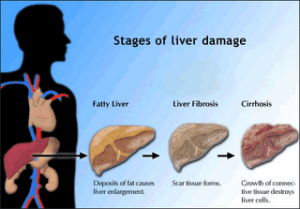90% of all diabetes cases are due to type 2 diabetes, which is associated with being overweight or obese. The other 10% are due to type 1 diabetes, which is caused by an autoimmune disease within the pancreas destroying the insulin producing beta cells. Diabetes, type 1 often occurs in childhood (hence the name “juvenile diabetes”), while type 2 diabetes is a condition of the middle aged and older population. There is however an alarming trend: overweight or obese youngsters are also being diagnosed with type 2 diabetes. Here I am discussing type 2 diabetes.
Causes that trigger diabetes
There is not just one way to get diabetes; it usually is a multifactorial disease. Sure, genetics play a minor role. But you need to have epigenetic factors to trigger the genes to develop diabetes: eating too much sugar, eating wheat and wheat products, drinking soda drinks that contain sugar or high fructose corn syrup. Alcohol binges can also cause diabetes as can accumulation of excessive weight (a body mass index above 25.0). Even when there is no genetic risk in your family (your family tree has nobody that came down with diabetes and all your ancestors lived into their 90’s), you can still develop diabetes, if you are exposed to one or more of the risk factors mentioned.
What is the reason why diabetes occurs?
At a Keystone Symposium from Jan. 27 to Feb.1, 2013 in Keystone, Colorado (Ref.1) leading scientific researchers gathered to discuss exactly this question. There seem to be several mechanisms, all of which lead to diabetes. It has been known for some time that in type 2 diabetes insulin resistance develops that renders the cells incapable of absorbing blood sugar (glucose) from the blood into the cells. It is because of this insulin resistance that doctors can diagnose diabetes when blood sugar levels are high.
There are at least 5 mechanisms that are presently known that can cause insulin resistance (and thus diabetes) by itself or in combination. For a deeper understanding of diabetes it is crucial to be aware of these. Without knowing the enemy, you cannot fight it.
1. When a person eats too much sugar or fructose the liver converts this into excessive fat that is accumulated in the body’s cells. As a result insulin receptors are becoming inefficient in absorbing sugar from the blood, and blood sugar levels stay high. The pancreas reacts to this by making even more insulin, which after a few years will cause the pancreas to fail in producing insulin. At this point the patient requires insulin or else gets into a diabetic coma.
2. Chronic inflammation is another mechanism that has been shown to cause insulin resistance. Obesity, the metabolic syndrome and diabetes have a common inflammatory denominator that results in insulin resistance. With the aging process there is also deterioration of mitochondrial function (mitochondria are the mini batteries inside of every cell that are responsible for you having energy). This causes fat accumulation and also insulin resistance. Exercise and weight loss are effective in combatting insulin resistance. Fasting has also been shown to improve insulin sensitivity.
3. The metabolism of visceral fat (the type of fat causing the apple appearance in obesity) is highly active and is associated with an increased risk for heart attacks and developing diabetes. The pear shaped woman runs less of a risk, as the fat around the hips is not metabolically active. On the other hand when these women enter into menopause, they also develop abdominal fat (apple-like fat distribution) with a high secretion of inflammatory substances causing insulin resistance, heart attacks and strokes.
4. Another mechanism of causing inflammation comes from invasion of organs with fat cells. The development of fat toxicity from these displaced fat cells can also cause insulin resistance. Heart cells have been shown to die from fat toxicity and in the pancreas the insulin-producing cells can be killed by fat toxicity as well causing diabetes or making existing diabetes worse.
5. Interestingly another line of research, namely researching binge drinking, has revealed that there is a short-term insulin resistance that lasts for several days until the alcohol has been properly metabolized. It is of concern that adolescents who are experimenting with binge drinking are very vulnerable to develop brain damage from this habit.
Consequences of insulin resistance
We know that insulin resistance is the cause for adult onset, type 2 diabetes. It is entirely preventable. But there are powerful influences on people’s lives that will allow one or more of these factors mentioned to cause diabetes. The most common cause is putting on excessive weight. The reason for this is that people like to eat fast foods, drink sugar-containing sodas, and feast on processed foods, bagels and cookies. The end result is a change of the metabolism with an increase in triglycerides from the liver, an increase in LDL cholesterol, particularly the very low-density lipoprotein sub fractions of cholesterol. It has been known for some time that this is the connection to the high, premature death rates from heart attacks in diabetics, in people with obesity and in people with the metabolic syndrome. Hardening of the arteries is accelerated by the deposition of foam cells in the walls of arteries. These are scavenger cells (macrophages) that have engulfed noxious fats. This leads to narrowed coronary arteries and also a general narrowing of arteries all over the body including the brain vessels. In diabetics hardening of the arteries is accelerated and leads to premature strokes, heart attacks and heart failure, kidney failure, blindness and amputations of limbs.
Important tests for borderline diabetics
I you have a fasting blood sugar that is above 100 mg/dL (5.5 mmol), but less than 126 mg/dL (7 mmol) you are considered to be prediabetic or “borderline diabetic”. In this case rather than waiting for disasters in terms of cardiovascular disease, take action and ask your doctor to do the following three tests.
a) Arrange for a glucose tolerance test where you are given 75 grams of glucose; then blood tests are taken at one, two and three hours after this challenge dose. These blood tests are checked for blood glucose levels and insulin levels and tell the doctor exactly what is going on in terms of your sugar metabolism. It shows the glucose clearance and also the insulin response from your pancreas.
b) Have a hemoglobin A1c test done: it shows how your blood sugars have been controlled over the last 2 to 3 months.
c) You also need a VAP (vertical auto profile) test, which tests your lipid profile. Both prediabetics and overtly diabetics have been shown to have lipid profile disorders. Apart from low values in sub fractions of HDL cholesterol this test will also measure the very-low density lipoproteins (VLDL), which has been shown to be responsible for heart attacks and strokes.
With these three tests your doctor can tell you more accurately what treatment protocol you require to succeed in controlling or curing your pre diabetes or diabetes.
Conventional treatment of diabetes
The conventional treatment of diabetes is to send the patient to a dietician, to ask the patient to do regular exercises and to either start them on hypoglycemic drugs or on insulin injections. Unfortunately the dietician often will encourage the patient to eat “healthy multigrain bread”, which will stimulate your taste buds to eat more sugar, high fructose corn syrup and starchy foods making weight loss impossible. Often the treating physician is satisfied that a hemoglobin A1c of 7% or less is good enough for the diabetic. But non-diabetic people have a hemoglobin A1c of 4% and 5.6%. This should be your goal or you will suffer the consequences of uncontrolled diabetes.
This is what I would call the conventional, symptomatic treatment approach. This may be the approach for patients who are not willing to seriously change their lifestyles, but it is more powerful on the long-term to treat diabetes by treating the underlying causes.
Alternative treatment approach for diabetes
Based on the above discussion regarding the various causes of insulin resistance, it is important to analyze what would be the main contributory factors in your particular case of diabetes.
Here are some suggestions:
1. If you are on the typical North American diet, also known as Western diet, it would be important to face the fact that wheat, wheat products in processed foods and sugar including high fructose corn syrup are the main culprits in stimulating your appetite and making you a sugar and wheat addict. Ref. 2 describes this in detail and offers 150 recipes to overcome this addiction. For more information just follow this reference text. Essentially it is a wheat-free Mediterranean type diet without rice, pasta and bread. You will shed significant amounts of pounds within a short period of time and feel a lot more energetic (due to revitalization of your mitochondria). At the same time insulin resistance is disappearing, because the insulin receptors are fully functional again. The insulin production of the pancreas will go down to normal levels and fat from the visceral fat storage gets melted away resulting in less inflammatory substances circulating in your blood.
2. A regular exercise program in a gym with an aerobic component (30 minutes of treadmill for instance and 20 to 30 minutes of isometric machine exercises) will help you to lower the triglycerides, and increase the healthy HDL cholesterol. It will also improve insulin sensitivity and control inflammation in your body. The best is to exercise 7 days per week. Remember your body works for you 7/7 every week, but for those of you who need a little rest in between 5 days per week is still very good. You may have to adjust your medication and insulin dose downwards, ask your physician about that.
3. Cut out alcohol. This may sound radical to you, but studies show this to be true. I have not mentioned cutting out smoking (it is causing inflammation and insulin resistance), because this is an absolute must that is given. When it comes to alcohol, the famous 1 drink per day for cardio protective purposes may not show up statistically as a bad effect, but your body will nevertheless get the message and let you age somewhat faster than a person who stays sober all the time. Staying sober will allow your brain to think clearly and adhere to your overall lifestyle approach in treating diabetes. Cutting out alcohol protects your brain (including the hypothalamus), liver and pancreas and prevents the prolonged periods of insulin resistance mentioned above that last for days. By keeping your hypothalamus in good working order, your hormone balance will stay stable for as long as possible until you reach menopause (for women) or andropause (for men). When you reached this milestone, I suggest you engage in bioidentical hormone replacement, which I have reviewed here. Hormones are essential to keep you younger for longer.
4. It is useful to monitor your blood sugar with a home glucometer, as this will show you when your blood sugar normalizes. Stay in touch with your doctor at all times, as this will help you in your overall management of your diabetes. Also, you will want to discuss with your doctor that you should have a blood tests called “hemoglobin A1c” measured every three months to see how well your diabetes is controlled. It should be below 7% for sure, but better below 6%. Non-diabetic people have levels of 4% and 5.6%. You may not know that hemoglobin A1c is actually measuring the amount of advanced glycation end products (“AGE”) of red blood cells. These AGE substances essentially are firmly bound sugar/protein compounds that shut down the cell metabolism wherever they are formed. In my opinion it is best to aim at a hemoglobin A1c level of non-diabetic people (4% and 5.6%) to avoid the consequences of tissue damage of all vital organs, which is the reason why long-term diabetics have a life expectancy of 15 to 20 years shorter than non-diabetic persons. Some diabetic patients may benefit from the oral hypoglycemic drug, metformin (brand name: Glucophage), which has anti-inflammatory properties and is used in patients with type 2 diabetes and a high fasting insulin level, but this is a decision requiring your physician’s input.
5. Supplements: There are some supplements that are useful to take as an adjunct, like chromium, which helps insulin to transport glucose into the cell; alpha-lipoic acid, an antioxidant, which is useful to prevent glycation (formation of a complex between sugar and protein, which prevents normal cell functioning); and coenzyme-Q10, which supports your heart (A4M recommends 400 mg per day, higher than Dr. Weil’s link). Other supplements of merit are curcumin, cinnamon, genistein and silymarin (standardized extract of milk thistle), which suppresses a pro inflammatory molecule, which in turn helps to fight insulin resistance (Ref. 1). Omega-3 fatty acid supplements are anti-inflammatory and will improve insulin resistance as well (dosage 1000mg or more per day). According to Ref. 3 vitamin D3 is useful as a supplement for diabetics, because it activates DNA, is involved in cellular repair and deficiency of it is known to lead to higher mortality rates in diabetics. Ref. 3 recommends between 1000 and 4000 IU of vitamin D3 daily and suggests doing blood tests to measure effective vitamin D3 levels (keep 25-OHD in the blood between 30 and 80 ng/mL).
6.Patients whose pancreas no longer produces insulin will need insulin injections, but instead of using long-acting insulin once per day the best results in getting blood sugar control is by injecting insulin three or more times per day using short acting insulin. It is important to always monitor the blood sugar lowering effect by glucometer readings; the injections are best given just before meals (recombinant human insulin is the preferred insulin to be used). Ask your physician or diabetic coach for more details.
Conclusion
Diabetes used to be a dreadful disease that caused premature heart attacks, strokes, blindness, kidney failure, and limb amputations. With aggressive management of diabetes as well as strict lifestyle intervention this has changed. A diabetic who treats the causes of the illness can have a normal life expectancy. In many cases the initial diagnosis of type 2 diabetes can disappear, when treatment was started early enough and insulin resistance could be stopped in its tracks. Without the patient’s full co-operation disciplining him/herself to follow through on all of these recommendations the caregiver will fail in controlling the patient’s diabetes. It is the patient who owns the problem; it is the patient who needs to make every possible effort and follow through on all of the details of dieting, exercising, blood sugar monitoring using a glucometer and taking the required supplements.
More information on diabetes: http://nethealthbook.com/hormones/diabetes/type-2-diabetes/
Reference
1. http://www.lef.org/magazine/mag2013/oct2013_2013-Keystone-Diabetes-Symposium_01.htm
2. William Davis, MD: “Wheat Belly Cookbook. 150 Recipes to Help You Lose the Wheat, Lose the Weight, and Find Your Path Back to Health”. HarperCollins Publishers LTD., Toronto, Canada, 2012.
3. Rakel: Integrative Medicine, 3rd ed. © 2012 Saunders. Integrative Therapy; Supplements.
Last edited Dec. 17, 2014










